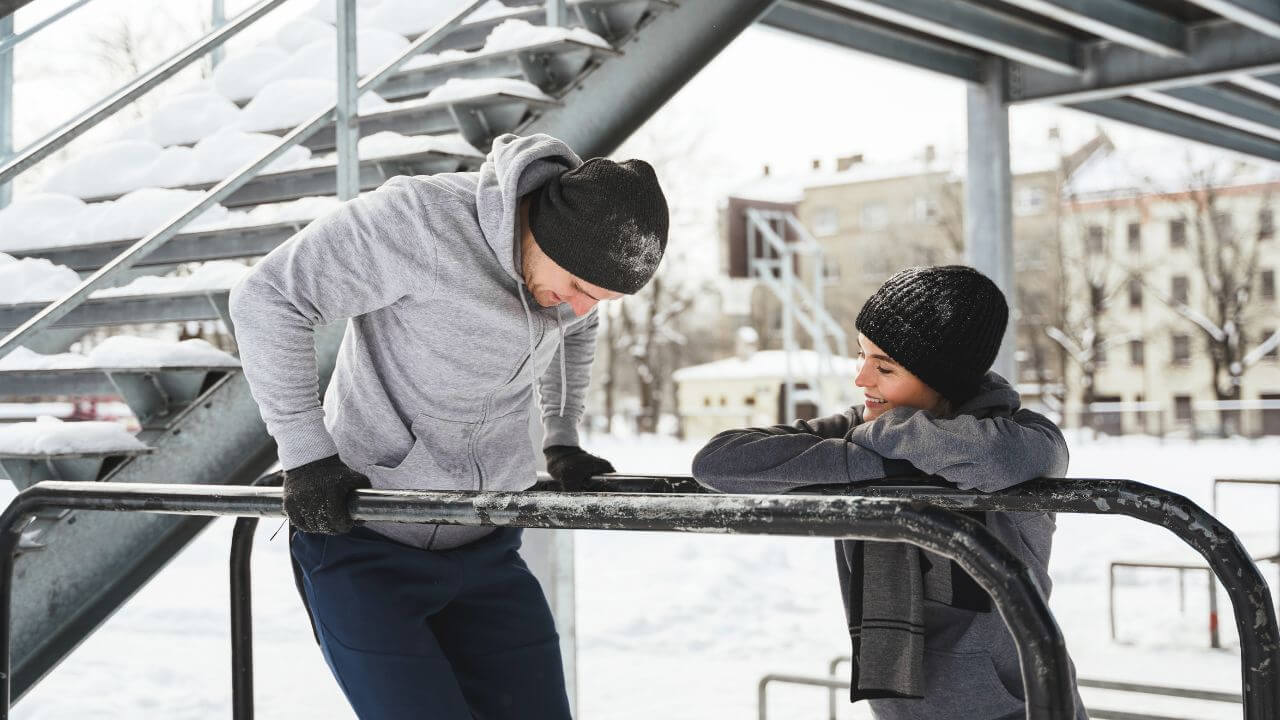Finding the motivation to train is difficult enough but in winter when it’s cold and the days are shorter we need an extra dose of willpower.
The easier solution is to go to the gym, and I do just that a couple of times per year. Nine out of ten times though, I choose to exercise outside. Calisthenics parks are less crowded then and I find the fresh air invigorating.
Exercising in cold weather outside is more taxing on the body and it is important to choose the right clothing, prepare the body for the additional challenge and modify the workout appropriately.
Below are a few tips on how to make the most of your winter training without getting sick or injured.
Adjust your training and prepare for the conditions
My summer workouts look completely different than my winter ones. In winter my workouts are short and sweet. When it's really cold I start with a 5 minute dynamic warm-up before proceeding to my workout. I perform no more than four exercises and I limit my training time to 25-30 minutes. In the summer I like spending time on the ground, while in winter I completely avoid it. In any case here are my recommendations:
Warm-up
It’s always important to include a short dynamic warm-up in your workout, regardless of the weather. In cold it’s even more essential to spend a few minutes doing some light cardio to warm up your muscles and get your blood flowing before you start exercising. The goal is to elevate your heart rate. Usually, 5-10 minutes are sufficient.
Any dynamic exercise does the job, for example:
- jumping jacks
- shadow boxing
- running in place
- skipping rope
- high knees
Dress in layers
It’s important to choose clothes in a way that allows freedom of movement while also keeping you warm without making you sweaty. Wearing multiple layers of clothing will trap heat against your body and help you stay warm. Start with a base layer made of moisture-wicking fabric, which will help keep you dry and prevent your sweat from cooling you down. The best for this purpose would be a Merino wool base layer. I've been using both a Merino one and a cheaper synthetic turtle neck base layer and for me both work just fine. Put a T-shirt and/or long sleeve sweater on top depending on the weather. I’d advise against a hard shell outer layer as a non-stretchy fabric will restrict your movement.
I usually do my workouts at medium intensity, meaning that my average heart rate is usually around 100-110 BPM and this is how I’d dress:
- 0-10°C (32-50°F):
- Long sleeve base layer
- T-shirt on top
- Wool hat
- Thin grippy gloves
- -10-0°C (14-32°F):
- Long sleeve base layer
- T-shirt
- Sweater
- Wool hat
- Snood
- Merino socks
- Liner gloves under grippy thin gloves
Protect your extremities
Your hands, feet, and head are most vulnerable to the cold, so make sure they are properly covered.
At cold temperatures, holding onto metal bars with bare hands can be painful. A pair of good-quality grippy gloves will be crucial to completing your workout sets without suffering. The gloves should have a grippy outer surface and be tight enough so they don’t move around too much on your hand.
When it comes to protecting your head I’d recommend a wool (merino or cashmere) hat or cap as its breathable fabric will minimize sweating while keeping you warm.
I have a sensitive throat so at freezing temperatures I always wear a snood on my neck.
To protect your feet from the cold I’d advise wearing a pair of merino socks. My feet are not overly sensitive so merino socks in sneakers are all I need in winter. If you need more warmth use a double sock layer.
Stay hydrated
In winter we sweat less and as a result, may not feel that thirsty but even in cold weather it’s essential to keep hydrated.
Dehydration can make you feel colder and may even cause hypothermia if coupled with a long workout in freezing temperatures.
Be sure to drink plenty of liquid before and during your workout. It can be cold, warm, a bowl of soup, or even from fruits.
Since my workouts are rather short in winter I drink a large glass of water just before leaving for the workout park, and it’s sufficient for me. For longer endurance workouts I put lukewarm isotonic drink into a thermos bottle. My goal here is to be able to drink without burning myself but at the same time prevent the liquid from freezing and replenish the lost electrolytes.
Shorten your workouts
At freezing temperatures, you don’t want to spend over an hour working out. Normally my workouts consist of about 4-5 exercises and 3-4 sets each. Completing this takes me about an hour. In cold weather, I reduce the number of exercises to 3-4 and shorten the rest time between sets. By doing so I’m able to complete the workout in about 35 minutes. To keep my weekly volume on target I increase the frequency of workouts, meaning that I train 4-5 times per week instead of the normal 3-4 workouts.
Use less rest time
When exercising in cold weather, it’s important to keep your heart rate elevated in order to avoid cooling down. In the unlikely event of feeling like sitting down to browse your phone when it’s freezing, I’d urge against it. Always keep moving.
Shorter rest time allows you to maintain your body heat and momentum, keeping your muscles warm and ready to work. This can help you avoid feeling stiff or fatigued between sets and can also help you maintain your focus and intensity throughout your workout.
Try to keep the rest time between 30-60 seconds and use it to ace around, circle your arms, or maybe even do some jumping jacks. Shorter breaks will make your workouts feel more intense and result in a different cardiovascular stimulation compared to your standard workouts.
Conclusion
What matters at the end of the day is that you move and stay consistent with your workout routine. It’s convenient and time-efficient to workout at home but the point I was trying to make is that it can be fun and rewarding to train outside all year round. Just create a good calisthenics workout plan and give it a go! I hope you found these tips helpful.
How do you make winter training more fun? Feel free to share in the comments.




